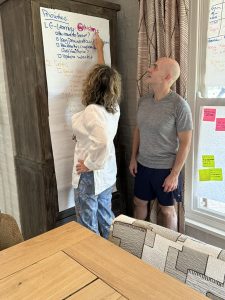
My Dimensions of Diversity (Natalie Spiro)
I am a woman with unique dimensions of diversity. Each aspect of my life contributes to a rich tapestry of experiences and perspectives. I
We’re driven by shared beliefs that allow us to work with all types of organizations across a wide range of industries to produce remarkable results.
A close-knit team with highly diverse backgrounds and skill sets, coming together with a singular purpose to deliver powerfully on your objectives and exceed your expectations.
To engage and retain talent in a rapidly evolving world, we must remain flexible and innovative in our approach to building and sustaining company culture.
Bringing in a professional coach is a smart path forward to unlock the potential observed in your leaders. Our certified coaches bring years of experience and can provide support and guidance. Empower and take your leaders to the next level.
We’re driven by shared beliefs that allow us to work with all types of organizations across a wide range of industries to produce remarkable results.
A close-knit team with highly diverse backgrounds and skill sets, coming together with a singular purpose to deliver powerfully on your objectives and exceed your expectations.
To engage and retain talent in a rapidly evolving world, we must remain flexible and innovative in our approach to building and sustaining company culture.
Bringing in a professional coach is a smart path forward to unlock the potential observed in your leaders. Our certified coaches bring years of experience and can provide support and guidance. Empower and take your leaders to the next level.

Part III in a series. Read part II, The Power of Engaging, Empowering Internal Communications.
Culture assessment: taking an in-depth look at how individuals, teams, and leaders view behavioral norms and identify talent strengths and weaknesses, along with employee expectations, engagement, and communication through surveys, focus groups, and interviews.
Most leaders recognize that their organizational culture evolves constantly, but looking back at 2020 and early 2021, they might see that fundamental shifts have occurred. As companies respond to the tumultuous challenges of the last 12 months, many are seizing an opportunity to lean into the positive changes that grew out of urgent necessities in the first days of the global pandemic and build a more positive future-thinking culture.
…organizations that successfully improve the working environment see increased productivity and business growth, which shareholders will notice and appreciate.
A great way to start this work is with a culture assessment, gathering feedback as a first step in forming an effective plan for the work and transformations ahead.
What did we learn?
Once the culture assessment has been conducted, it’s important to review and absorb the results. As plans are made for addressing the issues uncovered, leaders need to recognize the power of culture transformation, talent development, and navigating change. Transforming culture is a long-term and complicated process that involves defining, directing, enabling, and inspiring the desired changes. Key Performance Indicators (KPI’s)and Net Promoter Scores (NPS) should be identified and tracked, and pulse surveys launched to understand employee engagement as the change initiatives are enabled.
As an example, we have a current client in pharma who had planned for exponential growth in one of its critical divisions in 2020. Instead, they saw a substantial number of employees leave the company. They suspected the loss was due to disengaged leadership, and they came to us to clarify the precise root causes and other issues that were having many negative impacts on their organization.
As often happens when focusing on improving culture, you must strengthen the communications by increasing transparency and sharing the company-wide initiatives the company is embarking on.
The culture assessment identified a mixture of assets and liabilities, many that were not surprising, as some of these are challenges many organizations face. Among the assets were a strong brand, values, and mission, which are all good rallying points. The liabilities included weak enterprise-wide communications, siloes, poor leadership and manager communications, and limited cross-functional collaboration.
Accentuate the positive
The client expressed some initial concerns they had more liabilities than assets. While a clear understanding of liabilities or areas for improvement is required for this work, we never want an organization to lose sight of its strengths. We helped them analyze the results and determine the most effective ways to focus efforts for 2021 and beyond.
In this case, the company’s breakthrough science is an outstanding asset and a clear differentiator. We collaborated with their communications team to develop the narrative and identified ways to share it up, down, and across the organization. Enabling employees to tell “the story” has a positive impact not only on employee engagement and motivation, but also on recruiting and retention. As leaders communicate more frequently across multiple channels, including town halls, podcasts/videos, and intranet articles, they are reminding colleagues of the firm’s scientific achievements and instilling pride in their contributions.
In organizational culture work, big and small changes can be felt quickly, which can help leaders realize the importance of their investment in culture transformation initiatives.
As often happens when focusing on improving culture, you must strengthen the communications by increasing transparency and sharing the company-wide initiatives the company is embarking on. We created a multi-tiered program that reached all levels of the company. The offerings included:
The culture assessment identified a mixture of assets and liabilities, many that were not surprising, as some of these are challenges many organizations face.
Feeling the impact
In organizational culture work, big and small changes can be felt quickly, which can help leaders realize the importance of their investment in culture transformation initiatives. The impacts of these initiatives will grow over time, realizing significant progress and improvements throughout the year, and beyond.
What benefits will your organization see when it creates a more productive and supportive culture? Here are some of the positive outcomes:
While strengthening shareholder investment is not the primary aim of culture work, organizations that successfully improve the working environment see increased productivity and business growth, which shareholders will notice and appreciate.
With the seismic impacts of 2020 behind us, this is a great time to take stock of where you are and how to make 2021 a year of growth. In all likelihood, there are programs, systems, and even beliefs at your organization that need to be examined, adjusted, or left behind to move forward. Why not take this opportunity to build a stronger culture, ready to meet the challenges of 2021 and beyond?

I am a woman with unique dimensions of diversity. Each aspect of my life contributes to a rich tapestry of experiences and perspectives. I

Over the past year, in a coaching engagement, a client wanted to engage in inspiring and participating with their team to work together with more

In my professional life I was not lucky to have a mentor. I had people that supported me, gave me advice, and coached me, but